National Strawberry Month is celebrated during the month of May. It’s a good time to think about eating, growing, picking, serving and storing delicious and sweet strawberries. Strawberries are grown year round and Florida grows a lot of berries. https://sfyl.ifas.ufl.edu/lawn-and-garden/growing-strawberries/ It is great fun to go to a you-pick farm and pick your own basketful of berries, choose some at a local farmer’s market, and/or purchase them at your local grocery store. They are a beautiful, red fruit frequently enjoyed by all age groups.
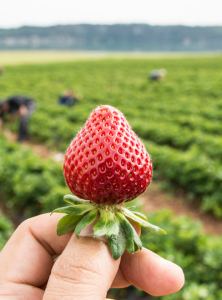
There is a new white variety of strawberries out on the market. https://blogs.ifas.ufl.edu/news/2020/12/01/white-strawberry-one-of-two-new-uf-ifas-varieties-ready-for-harvest-season/ I recently placed a package of these white strawberries in my grocery cart and an older gentleman next to me asked why I would buy unripe strawberries. I explained the white strawberries were a new variety that I had wanted to try. He said he was going to try them too and placed a container in his cart.
I really enjoyed the flavor, but the non-traditional, white color will take some getting used to. My family and I agreed, they were very tasty. We prefer the red variety only because that is what we are used to when it comes to eating strawberries. Try something new today! It’s a fun different experience.
Eating Strawberries and Health
Eat berries for good health. Most people love to eat strawberries. When you slice them in half, some of them take on the shape of a heart. When my daughter was a young toddler, she would ask me for a “frawberry” as she couldn’t yet fully pronounce the word strawberry. It was so cute! Fun times and cherished family memories can be formed during healthy snack time.
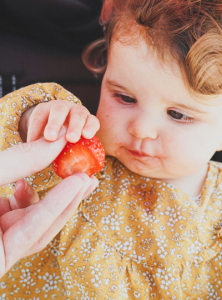
Add strawberries to salads, cereal, smoothies, refreshing sugar-free strawberry/mint flavored/diffused water, shakes, desserts or enjoy them alone. Take them to work or pack them in school lunches. I love a mixed fruit salad with sweet strawberries any day of the week. Many people eat strawberries daily for breakfast in oatmeal with strawberries and blueberries, cut up in a fresh fruit or vegetable salads, or alone as a healthy treat. Chocolate covered strawberries are a favorite around Valentine’s Day. Some individuals make their own fresh strawberry jam and/or jelly. The National Center for Home Food Preservation is the go-to place for science based canning information and vetted recipes. https://nchfp.uga.edu/how/can7_jam_jelly.html#gsc.tab=0
A cup of strawberries contains approximately 50-55 calories, 3.8 grams of fiber and is packed with Vitamin C. Fresh or frozen berries are both nutritious choices. https://web.extension.illinois.edu/strawberries/nutrition.cfm https://edis.ifas.ufl.edu/publication/FY215 Vitamin C supports a healthy immune system. https://www.eatright.org/health/essential-nutrients/vitamins/how-vitamin-c-supports-a-healthy-immune-system
Strawberries are part of a well balanced diet and fall within the fruit group on MyPlate. On MyPlate, the fruit group is the red group. https://www.myplate.gov/eat-healthy/fruits You have probably heard someone say, “Eat plenty of fruits and vegetables for good health.” They are correct. Fruits and vegetables are a great source of vitamins, minerals and fiber. They contribute to better health and are linked with a decreased incidence of chronic disease. As the slogan states: “Make ½ your plate fruits and vegetables”.

Look closely the next time you eat a strawberry. The tiny seeds on a strawberry contain fiber. Did you know? The average strawberry contains about 200 seeds. https://web.extension.illinois.edu/strawberries/facts.cfm Fiber found in fruits and vegetables and can help with your digestion. https://newsinhealth.nih.gov/special-issues/eating/rough-up-your-diet
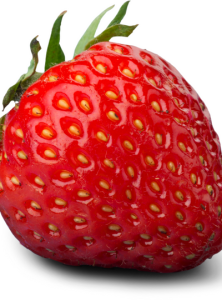
Growing Strawberries
There’s no time like the present to learn how to grow your own strawberries. Gardening is a great way to get out in nature, absorb some Vitamin D (the sunshine vitamin) and grow your own fruit. https://edis.ifas.ufl.edu/publication/HS403
There are many available resources. Extension master gardeners can teach you the basics on how to grow this sweet treat. Ask a master gardener in your county extension office for more information. A lot of literature is available on growing strawberries.
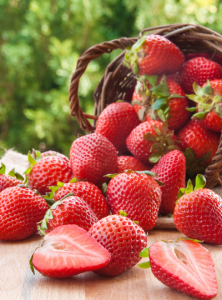
Washing and Serving Strawberries Safely
Always remember the basic principles of food safety to avoid a costly foodborne illness. There are four simple steps: Clean, Separate, Cook and Chill. https://blogs.ifas.ufl.edu/browardco/2022/02/08/engaging-in-food-safety-behaviors-does-matter/ Use the recommended FDA steps when washing fruit and vegetables. https://www.fda.gov/food/buy-store-serve-safe-food/selecting-and-serving-produce-safely These steps can protect you and others from illness. Harmful bacteria may be in the soil or water where produce grows and can contaminate produce. Fresh produce may also become contaminated after being harvested-during storage and preparation. https://www.fda.gov/media/77178/download
Always wash your hands before and after handling food to prevent food poisoning. Wash hands with soap and water for at least 20 seconds. Here are some additional tips:
- Purchase berries that are not bruised, damaged and/or contain visible mold.
- When bagging fresh fruit and vegetables at the store, bag them separately from meats, poultry and seafood. Avoid cross-contamination.
- Store fresh berries in a clean refrigerator at a temperature of 40 degrees or lower. Use a refrigerator thermometer to regularly check the temperature.
- Wash cutting boards between use with hot soapy water. Do not use the same cutting board that previously held raw seafood, meat or poultry. Again-don’t cross-contaminate. Consider running cutting boards thru the dishwasher after food preparation. https://blogs.ifas.ufl.edu/browardco/2022/01/28/cut-the-risk-from-your-cutting-boards/
- Cut away damaged and bruised areas of strawberries, before using or eating. Toss out rotten spoiled berries.
- Wash strawberries under running water before preparing or eating, removing dirt and debris.
- After washing strawberries, dry them with a paper towel to further reduce bacteria that may be on the surface of the berry.

Storing Strawberries
Don’t store them for too long inside the refrigerator. Eat your fresh fruit first. You can freeze strawberries for later use. You can buy them on sale and freeze for a later time. Once frozen, it is recommended that they are used within 12 months for best quality.
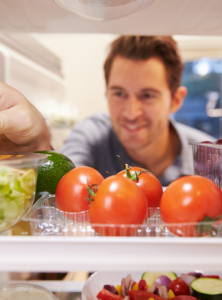
5 Steps to Freezing Strawberries
Freezing strawberries can be fun and can save you money at the grocery store. This way you can enjoy strawberries at anytime. See the UF/IFAS Extension step by step guide on how to freeze strawberries.. https://gardeningsolutions.ifas.ufl.edu/plants/edibles/fruits/strawberries.html#!/-1/
- SELECT dark red, ripe, firm strawberries.
- WASH thoroughly.
- REMOVE caps and stems.
- PACKAGE strawberries for freezing.
- PUT THE DATE on your storage containers or freezer bags.
Prevent Food Waste
Food Waste Prevention Week is held annually in April and is focussed on educating and inspiring change around food waste. This awareness helps families save money, reduce the negative environmental impact of food waste and addresses hunger in our communities. This is a good time to consider ways to stop wasting food and throwing it in the trash when it goes bad. Plan your fresh fruit into your menus first! Store fresh produce in the front of your refrigerator so it is visable. Don’t let fresh produce with a limited shelf-life get hidden on the back of the shelf or inside the crisper. Make it your mission to not waste food. Use wilted strawberries in smoothies, yogurt parfaits or cut them up into a salad. Don’t waste your food dollars. https://blogs.ifas.ufl.edu/browardco/2022/03/28/prevent-food-waste/
Spring had sprung and it is a great time to consume some seasonal juicy strawberries. Hopefully this article inspired you to eat healthy and focus on fruit, especially strawberries. I think I will go and eat a few healthy strawberries now!
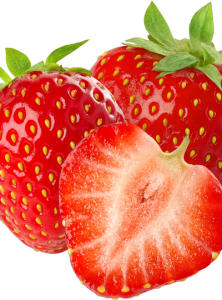
References to Learn More
Strawberries- https://snaped.fns.usda.gov/seasonal-produce-guide/strawberries
UF/IFAS Strawberry Varieties- UF/IFAS Strawberry Varieties – Gulf Coast Research and Education Center – University of Florida, Institute of Food and Agricultural Sciences – UF/IFAS (ufl.edu)
Follow the Rainbow for Good Health- https://blogs.ifas.ufl.edu/browardco/2022/03/01/follow-the-rainbow-for-good-health-during-nutrition-month/
An equal opportunity institution and employer.
 9
9
